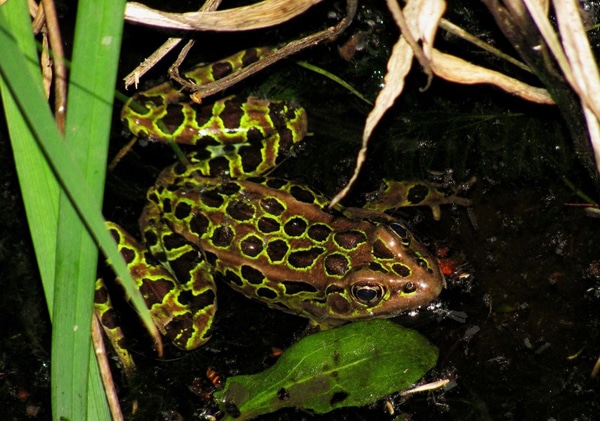Northern leopard frog (Rana/Lithobates pipiens) The Northern leopard frog (Rana/Lithobates pipiens) is a very colorful frog, and is surprisingly ea
Northern leopard frog (Rana/Lithobates pipiens)
The Northern leopard frog (Rana/Lithobates pipiens) is a very colorful frog, and is surprisingly easy to keep and raise in captivity. The variety of patterns and colors on this amphibian is amazing. Green to brown for the background color, and the spots can vary widely. From personal observation the East Coast population is mostly green, with all-brown being very uncommon, but in the Great Lakes region up to a fourth of them I’ve observed lack the green. As far as keeping them in captivity, they are similar no matter where they called “home.”
Read More
How Frogs Leap Amazing Distances
Herping the Florida Leopard Frog
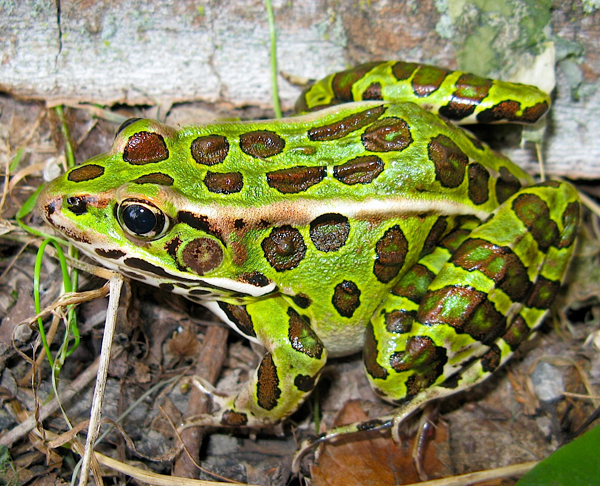
Joe Myers
The Northern leopard frog is a very colorful frog.
Availability
Anywhere within range these should be fairly easy to capture. Their prime habitat is the grassy/weedy edge of a small creek flowing through agricultural areas, or the weedy edges of ponds, and fish-free golf course ponds often hold many. The marshy edges of lakes usually hold a few as well, but they seem to avoid heavily-wooded areas and mountainous areas, even within their range.
When I lived in southern Ohio they were absolutely unheard of in the rugged hill country, but in the mile-wide flat river valley they were abundant in wet areas a mere walking-distance from the steep hillsides! Another way to get them is to mail-order them. This can be a bit pricey – averaging about ten dollars per frog once shipping is included. I have ordered them in the past from several different places with excellent results. One place in particular ships really beautiful leopard frogs, and this is eNasco.com.
The staff there is very friendly, and when I tell them these are for public display and for long-term captivity and not for dissection, they were always very happy to send me very pretty ones by request.
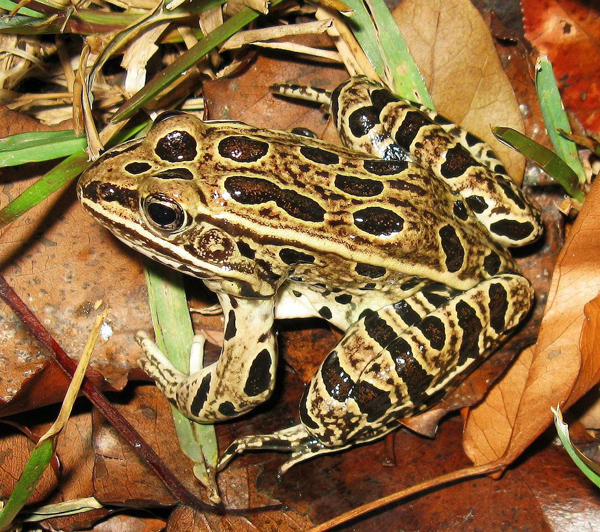
JOE MYERS
Some leopard frogs lack the green color entirely.
Besides the Northern leopards, there are also Southern leopards, and from experience these don’t do quite as well – being a bit more “hyper” in captivity, and a bit more prone to hide. Both Northern and Southern leopard frogs are about the same size (reaching about four inches in a sitting position), and I keep both together with no problems. Both do well in the North and South when kept outdoors in the summertime. The Southerns have a small light dot in the center of the eardrum, while the Northerns lack this.
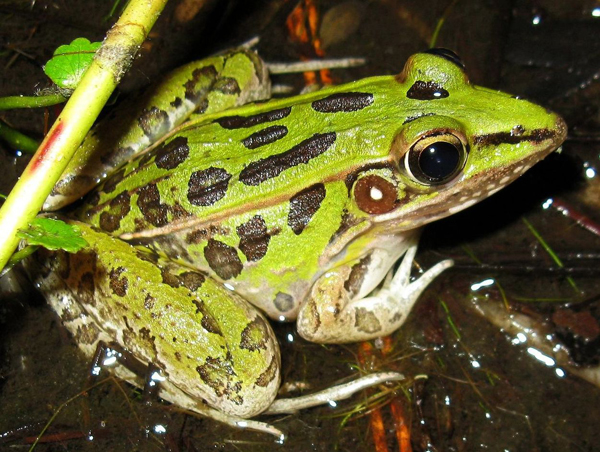
Joe Myers
The Southerns have a small light dot in the center of the eardrum, while the Northerns lack this.
The “Froggatorium”
This is a little invention that brings hours of joy to the summer camp program I have been a part which includes all the amphibian and reptile supplies for comfort. This screened structure holds around 40 adult frogs, and buried in the ground I have a “kiddie pool” that’s about 4 feet across, and about 8 inches deep, with a large potted Blue Flag Iris in the pool, along with some other native aquatic vegetation. Besides the pool, I keep most of the grass really short for feeding purposes, but keep it a bit taller near the pool and around the edges. When groups of people come to the nature center each one takes a big, fat, juicy nightcrawler and drops it into the “dry” area (not in the pool), and the fun begins! Soon it’s raining worms from above, and it gets very interesting in there. It’s very exciting for groups of all ages to interact with the frogs in such a way.
At night it’s a different story. I place a blacklight on the screen cover as I have to cover the top to keep the hawks, owls, herons, and raccoons out. Inside the Froggatorium near the ground I have another light that draws the insects to the ground, and it’s a lot of fun to sit out there at night, pull up a chair, and watch the “Blip! Blip!” of dozens of frogs snatching June bugs that are constantly flying in around them. The moths, beetles, Dobson flies, and countless other insects all add nourishment to the frogs on a nightly basis, while the worms are used mostly for “entertainment” when the groups stop by for their daily visits. I also have a slightly “less fancy” setup here in Florida, set up exactly the same inside, and to feed so many frogs I order night crawlers via mail-order. The light setup feeds them at night.
Joe Myers
This screened structure holds around 40 adult frogs.
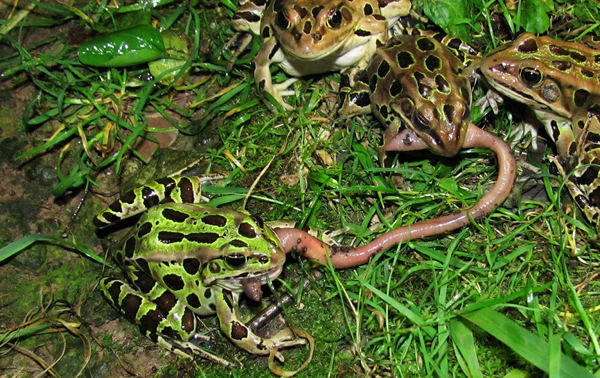
Joe Myers
Soon it’s raining worms from above, and it gets very interesting in there.
Keeping Them Indoors
Lacking a “Froggatorium” in your back yard, you may want to consider an aquarium. Remember a large aquarium can be heavy, and changing the water constantly can become a burden after awhile, so here’s an easy way to keep them indoors with easily available frog supplies. I use a 30-gallon aquarium with a bed of fairly large gravel, such as the Exo Terra Large Natural River Pebbles. If the gravel is too small it can get eaten during a feeding frenzy. When it comes to frogs eating rocks, I know this may sound kinda silly, but frogs aren’t too bright! Yes, they will gulp a rock thinking it’s a beetle, and the rock can quite possibly do them harm. Imagine how you’d feel if you swallowed a rock the size of a baseball!
Thankfully Northern leopard frogs tame readily, and adjust to changes. For example, at feeding time I slide the cover back, insert a piece of AstroTurf which is perfectly-cut to fit into place, and unroll it to cover the gravel. I feed them on this instead of on the rocks, and when feeding time is over I simply lift it back out and spray it off and it’s ready for the next feeding. Nice clean gravel, and most frogs will use the water container as their “bathroom” (more about that shortly), and if you keep no more than five frogs in a 30-gallon setup like this, any “real cleaning” is only needed every few weeks! Now to try this little “roll-out-the-carpet” trick with Southern leopards usually means you may be chasing them around the house! These are much more “jumpy” than Northerns, and are quick to go hyper the moment a hand is reached in there! If you can handle the risk of a cold webbed foot slapped against your cheek, followed by you chasing it around
the house and under heavy furniture, then the Southern leopard might be just the one for you. The Southern is a nice one to keep, and also very colorful – just a lot more jumpy.
Water and Light
Here’s the setup so far – A 30 gallon aquarium with some nice natural creek gravel, and a couple nice happy frogs. They’ll be thirsty soon,so we’ll give ’em some water. I use a black or dark green Rubbermaid-type container, and there’s a model that’s nearly perfect for this size aquarium. I simply place it atop the gravel, and on the opposite end of the aquarium I place a reflector, such as the Zilla Premium Reflector & Heat Black Ceramic Dome Lighting Fixture on the screen cover with a 40-watt light bulb. This gives them a bit of heat. The Northerns will usually gravitate toward the heat. Where are the Southerns? Usually cowered together in a corner, or crammed into the space between the water container and the glass of the aquarium! Also a small slab of slate is nice to have under the light, and it gives them something smooth to sit on if they’d like. They will spend a good bit of time basking, especially after a meal, and if they spend ALL their time basking, try increasing to a 60-watt bulb, since they may not be warm enough with
the 40-watt. Also at cleaning-time, I simply lift out the water container, change the water, and place it back in there. This water container is also their “bathroom” much of the time, and this makes cleaning a cinch!
Food
Whenever I pick up a new leopard frog, I always ask myself “Is this frog big enough to eat a rat?”. Usually once a month or so I’ll give my frogs a baby rat. This seems to be a burst of energy for them, but don’t want to overdo rats, because who wants a leopard frog as wide as it is long??! Leopards by nature are sleek and slender, and live by sitting in the tall grasses and watching for crickets to scurry across their path, or a katydid or grasshopper climbing up a stalk of grass. On rainy nights they will wander far afield looking for worms, or even smaller frogs, and when there’s a fresh hatch of toads for example, this will attract MANY leopard frogs (as well as other animals) to the feeding frenzy. A “free” food source (in warm weather at least) is to turn on your porch light, and grab what flies in. Avoid feeding them things that can sting or
bite, such as large spiders, hornets, honeybees, etc. Even ants are a bit too “spicy” for them, but some live herp food favorites for them include moths, worms, crickets, grasshoppers, waxworms, and mealworms. The key here is VARIETY. All are good, but to mix them as much as possible will assure a perfectly healthy frog, and a happy frog owner.
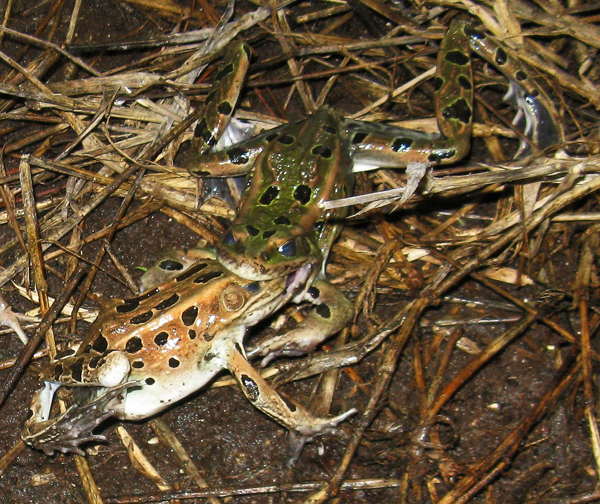
Joe Myers
Sometimes while feeding they’ll strike at anything that moves – including each other! This is why it’s best to keep only similar-sized frogs together. No frogs were harmed in this incident.
What to do in the Winter
If you’d like, and if the cost of live food is no problem to you, the very best thing is to keep them going right through the winter, right there beneath their little “artificial sunshine” known as their heat lamp! If you keep them outdoors, and if you live within their range, and finding new ones is no problem to you, simply release them all in September close to where you got them and start anew in the springtime. However if you choose to hibernate them, this is an option that is at best a “last resort”, since this may result in total success, death, or a thousand tadpoles! Let’s say you live in the North and you keep them outdoors, the water must be at least a couple feet deep, and in October place some waterlogged branches in the bottom, as well as some dead leaves and cattail leaves for example, and a rock or two perhaps, and when the ice and snow finally leaves in late winter, let’s hope you have frogs!
What’s that noise?? Those are the males that survived the winter all croaking loudly, and soon you’ll have egg masses. These must be removed and placed in someplace separate, and be prepared to release them in a known habitat for leopard frogs. If you know of no such place it may be hard to humanely destroy them, but this must be done. To release any species of animal (reptile, amphibian, or otherwise. Just ask any New Englander about the Gipsy Moth!) into a new area can create an ecological DISASTER! If you wish to try a few tadpoles, pinch off a little piece of the egg mass and be ready for that many more Leopard frogs in about a hundred days!
If you feel safer hibernating them indoors, take a large plastic container and fill it with about two inches of loose, very moist soil, and on top of this place dead leaves to near the top and place it in the refrigerator. Once chilled, add your frogs which have also been chilled and ready. Make sure there are a few holes in the lid, and check on them about once a month by digging into the leaves to see if they look moist and healthy. Sprinkling may be necessary, because the frogs will absorb water as they sleep. To prepare your frogs for hibernation, gather them in late-October or November before the water freezes and add them to the container. On a very important note – One must NEVER take a healthy, warm, actively-feeding frog and plunge it into hibernation, as this will be a sure death. They must be slowed-down very gradually over several weeks or more if they are to be hibernated. As shared earlier, it’s best NOT to hibernate them, since they will
do very well if kept heated indoors, and you won’t have to worry about all those eggs, and what to do with them! Anyway the best time to re-awaken hibernating frogs is April, or whenever the ground is thawed.
These have always been one of my favorite animals to keep, since they’re amusing, colorful, and worry-free. Even freshly-caught adults tame quickly, and each one live about 4 to 6 years.
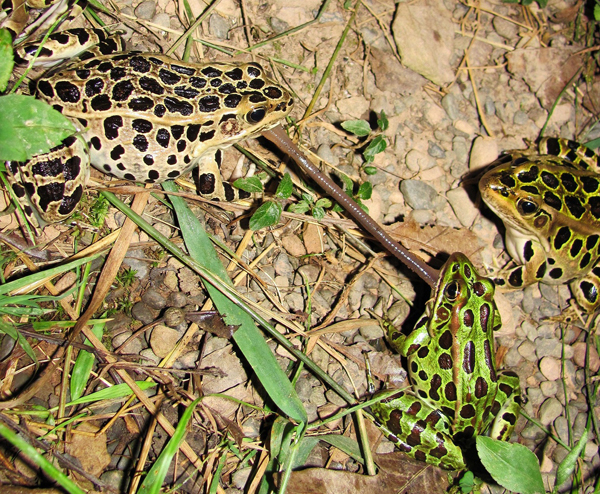
joe myers
Northern leopard frogs are amusing, colorful, and worry-free.
“Nature” Joe (Myers) has been keeping and breeding leopard frogs for many years, and working with groups of people of all ages in an outdoor educational setting since 1986, and can be followed on Facebook https://www.facebook.com/n.joe.myers where his nature photography can be seen publicly.

